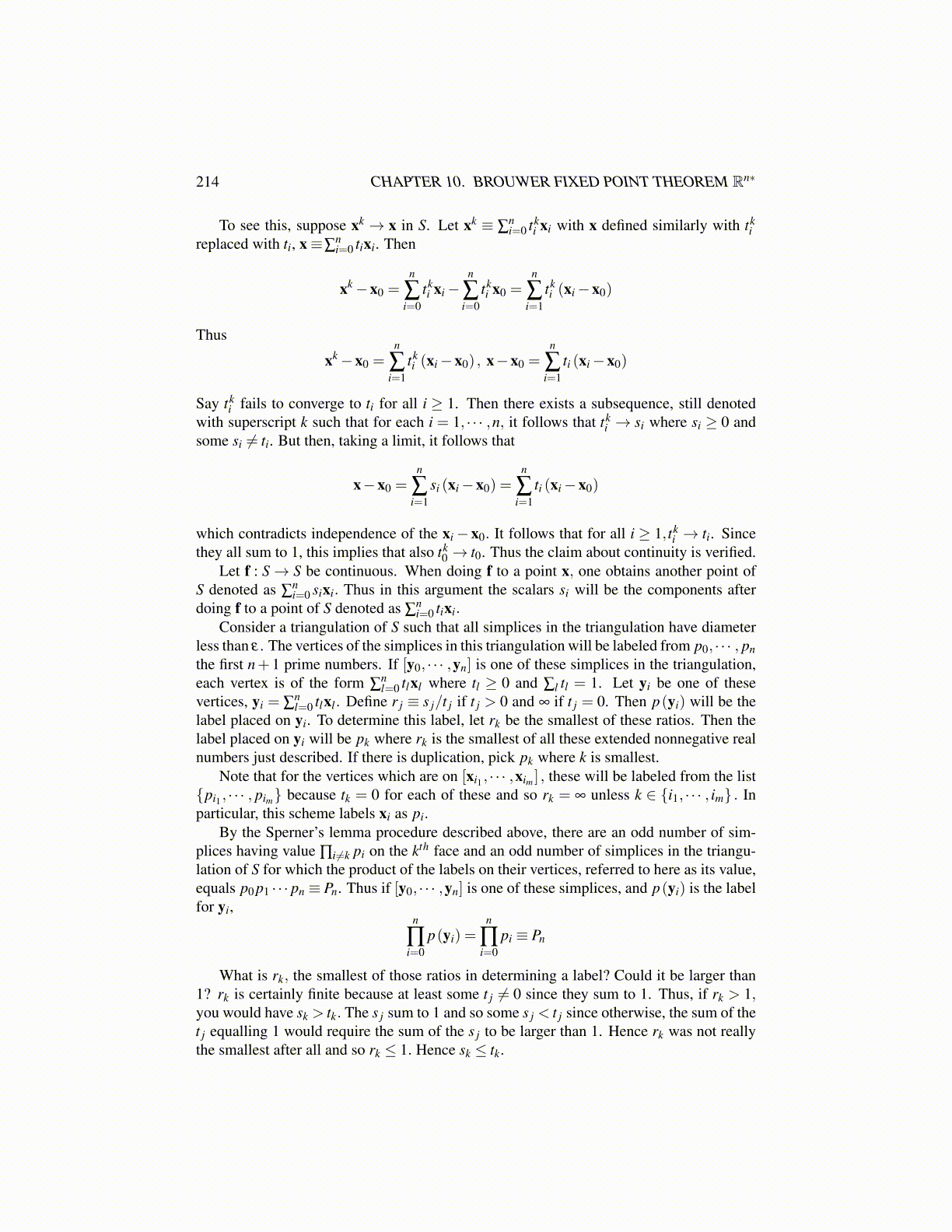
214 CHAPTER 10. BROUWER FIXED POINT THEOREM Rn∗
To see this, suppose xk → x in S. Let xk ≡ ∑ni=0 tk
i xi with x defined similarly with tki
replaced with ti, x≡∑ni=0 tixi. Then
xk−x0 =n
∑i=0
tki xi−
n
∑i=0
tki x0 =
n
∑i=1
tki (xi−x0)
Thus
xk−x0 =n
∑i=1
tki (xi−x0) , x−x0 =
n
∑i=1
ti (xi−x0)
Say tki fails to converge to ti for all i ≥ 1. Then there exists a subsequence, still denoted
with superscript k such that for each i = 1, · · · ,n, it follows that tki → si where si ≥ 0 and
some si ̸= ti. But then, taking a limit, it follows that
x−x0 =n
∑i=1
si (xi−x0) =n
∑i=1
ti (xi−x0)
which contradicts independence of the xi− x0. It follows that for all i ≥ 1, tki → ti. Since
they all sum to 1, this implies that also tk0 → t0. Thus the claim about continuity is verified.
Let f : S→ S be continuous. When doing f to a point x, one obtains another point ofS denoted as ∑
ni=0 sixi. Thus in this argument the scalars si will be the components after
doing f to a point of S denoted as ∑ni=0 tixi.
Consider a triangulation of S such that all simplices in the triangulation have diameterless than ε . The vertices of the simplices in this triangulation will be labeled from p0, · · · , pnthe first n+1 prime numbers. If [y0, · · · ,yn] is one of these simplices in the triangulation,each vertex is of the form ∑
nl=0 tlxl where tl ≥ 0 and ∑l tl = 1. Let yi be one of these
vertices, yi = ∑nl=0 tlxl . Define r j ≡ s j/t j if t j > 0 and ∞ if t j = 0. Then p(yi) will be the
label placed on yi. To determine this label, let rk be the smallest of these ratios. Then thelabel placed on yi will be pk where rk is the smallest of all these extended nonnegative realnumbers just described. If there is duplication, pick pk where k is smallest.
Note that for the vertices which are on [xi1 , · · · ,xim ] , these will be labeled from the list{pi1 , · · · , pim} because tk = 0 for each of these and so rk = ∞ unless k ∈ {i1, · · · , im} . Inparticular, this scheme labels xi as pi.
By the Sperner’s lemma procedure described above, there are an odd number of sim-plices having value ∏i ̸=k pi on the kth face and an odd number of simplices in the triangu-lation of S for which the product of the labels on their vertices, referred to here as its value,equals p0 p1 · · · pn ≡ Pn. Thus if [y0, · · · ,yn] is one of these simplices, and p(yi) is the labelfor yi,
n
∏i=0
p(yi) =n
∏i=0
pi ≡ Pn
What is rk, the smallest of those ratios in determining a label? Could it be larger than1? rk is certainly finite because at least some t j ̸= 0 since they sum to 1. Thus, if rk > 1,you would have sk > tk. The s j sum to 1 and so some s j < t j since otherwise, the sum of thet j equalling 1 would require the sum of the s j to be larger than 1. Hence rk was not reallythe smallest after all and so rk ≤ 1. Hence sk ≤ tk.